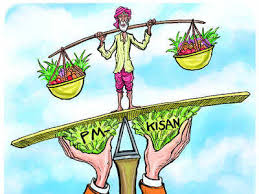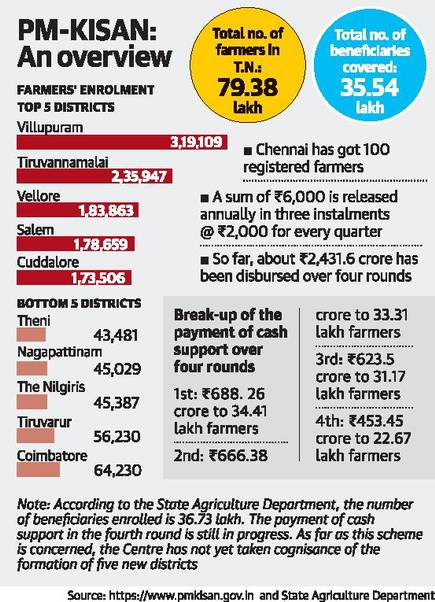Relevance: Prelims/mains: G.S Paper II: Polity: Governance: Government schemes and policies
Context:
- Pradhan Mantri Kisan Samman Nidhi, popularly known as PM-KISAN, announced in December 2018 was a tectonic shift in the nature of government support to farmers in India.
• This scheme was aimed at addressing the liquidity constraints of farmers for meeting their expenses for acquisition of agricultural inputs and services.
About the scheme:
- This scheme is particularly important in a country like India, where still about half of the farming households do not have access to formal credit.
• The scheme implemented from February 2019 provides each eligible farmer’s family ₹6,000 per annum in three instalments of ₹2,000 each.
• Initially, farmers with less than two hectares of land were eligible; subsequently, the benefit was extended to all farmers (about 140 million farmers) from June 2019 onwards. The amount is transferred directly to the beneficiary’s bank account to check leakages.
Different from existing schemes:
- By its design, PM-KISAN is positioned as an income support to the farmers. The launching of this scheme generated a serious discussion in the policy discourse in India.
• The timing of the announcement made this scheme appear as a politically motivated move to appease the farming community on the eve of election.
• However, this is a clear departure from the existing systems of support to the farmers and the scope of PM-KISAN goes much beyond, especially in the case of resource-constrained farmers with significant liquidity problems.
• The effects in principle could be related to the choice of technologies and practices that could have significant effects on farmer’s income and welfare.
• The scheme has now completed almost a year and the third instalment was transferred recently by Prime Minister Narendra Modi.
• But a proper understanding of the implications of this ambitious farmer income support programme is virtually non-existent.
Empirical study:
- The International Food Policy Research Institute (IFPRI) in association with the Indian Council of Agriculture Research (ICAR) embarked on a study to empirically assess technology choices and adoption of practices following the rollout of PM-KISAN.
• Since the study focussed on technology choices for the beneficiary farmers, it realised that adoption of technology for resolving liquidity issues is just one cog in the wheel. Knowledge and extension support is also needed to bring about adoption.
• Taking the primary objective of fostering timely usage of inputs, that is, technology, the study, based on primary survey, evaluated the implementation of PM-KISAN and the role of Krishi Vigyan Kendras with strategic complementarity for magnifying its impact. The study focussed on Uttar Pradesh, which is home to 24 million farmers.
• Our study reveals that 30 per cent farmers received the income benefit within three months of the scheme’s implementation. Banking infrastructure created through Pradhan Mantri Jan Dhan Yojana (PMJDY) played a key role in the fund disbursal.
• Programmes like this are often subject to elite capture and selection biases. But our findings depicted no selection bias in terms of social, economic, and farming characteristics.
• Further, 93 per cent non-beneficiary farmers had already applied for the scheme, depicting awareness and potential uptake. When augmented with extension through KVKs, the adoption of modern inputs is significantly higher (to the tune of 36 per cent).
Spending pattern:
- The first instalment was received by the farmers in February 2019, which may be characterised as the agriculture peak season (in terms of spending requirements), while the second instalment was received by the end of April 2019, characterised as the agriculture off-season.
• Results show that of those who received the first instalment, 52 per cent spent it on agriculture, 26 per cent on consumption, 7 per cent on education and health, and the remaining 15 per cent on other incidental expenses (such as during festivals and on social functions like marriage).
• Among the recipients of the second instalment, 39 per cent spent it on consumption, followed by agriculture (23 per cent) and education and medical (19 per cent).
Way forward:
- Therefore, PM-KISAN along with agricultural advisory services has the potential to break the cycle of intergenerational poverty and low income of farmers through investment in modern technology.
• A direct transfer scheme like PM-KISAN is a game-changer and can have significant effects if it is timely, not transaction cost heavy and is provided with complementary inputs such as extension services.



